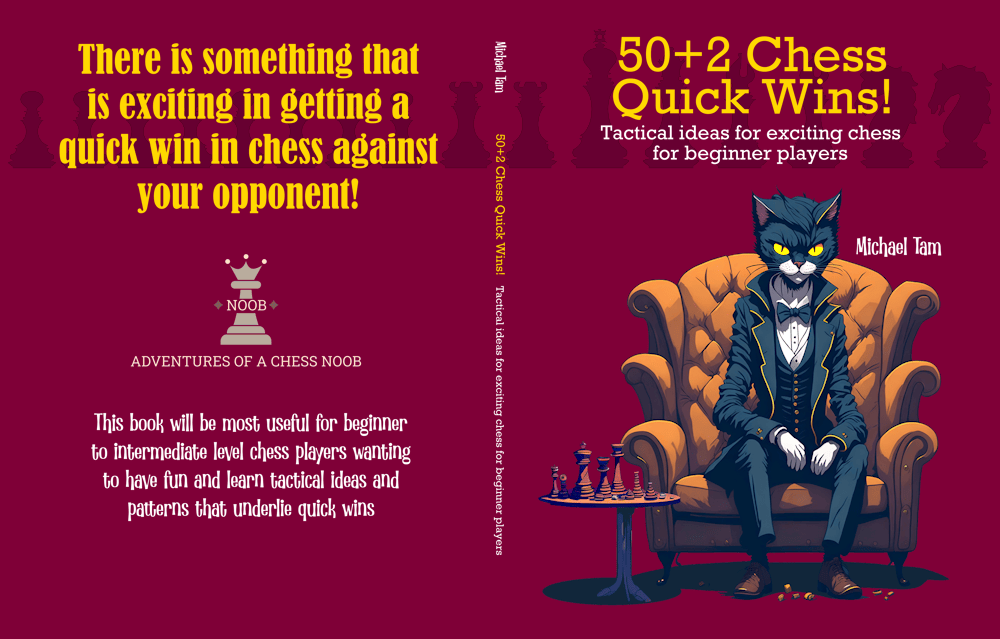
Englund Gambit Queen Sacrifice | BEAUTIFUL DRAW in a line of gothic horror 😱♟️
#englundgambit #queensac #chessromance
I haven’t played a daily game in a while but enrolled in the currently running under-1500s Team New Zealand vs Team Australia (Sydney NSW) tournament. I’ve just finished this amazing game against my Kiwi opponent.
If you follow my blog and channel, you’d know that I love exciting and tactical chess in the Romantic style. As is sometimes the case, my opening gambit or attack doesn’t work out, but then we have the rest of the game to try to get a reversal – wrangling at least a draw if not a win with tricky manoeuvres and pirate tactics, i.e., unsound, illegitimate, but swashbuckling fun!
My first game has just finished, and I must share it! My opponent played the very civilised Queen’s Pawn Opening and I, of course, respond with the Englund Gambit (1. d4 e5)! We go into the Englund Gambit Complex and my opponent impressively starts the refutation line (2. dxe5 Nc6 3. Nf3 Qe7 4. Bf4 Qb4+ 5. Bd2! Qxb2 6. Nc3! Bb4 7. Rb1!). You’d note that to find the refutation White must play three consecutive excellent moves (as rated by the chess.com analytic engine), which isn’t so easy for beginner-intermediate players. When analysing the data from the Lichess community database, the refutation from the Englund Complex position (4… Qb4+) is only played this only occurs around 41% of the time for all games, and only 22% of the time when limited to players rated ELO 1000 and below.

![]()
For this reason, the Englund Gambit is often labelled (with understandable rationale) as “hope chess” as the refutation is not especially hard to find, and Black seems to have completely lost the initiative from this point. To avoid the queen being captured, the forced move is (7… Qa3), an awkward move to the edge of the board, and White now has activity, development, and an obvious powerful attack by advancing the queen’s knight on c3 to d5, a fork on Black’s b4-bishop and Black’s c7-pawn which would come with an absolute fork of the king and a8-rook. Disastrous!
My view, however, is that one only plays the Englund Gambit if they are willing to double down with aggressive and sacrificial tactics. And what could be more adventurous and dastardly than sacrificing your own queen! 🤪👍
We don’t have to play the accurate but withering (7… Qa3), which is a move that can only be characterised as Black waiting to die. Instead, there is the magnificent Queen Sacrifice Line of (7. Qxc3!?).

![]()
What is the logic behind this mad looking move? Well, the next moves are obvious and practically forced – White captures the queen with their bishop, and Black captures back with check, and White must block the check with their knight or queen (knight obviously!): (8. Bxc3 Bxc3+ 9. Nd2).

![]()
Black has traded their queen for two minor pieces (a knight and bishop) and a pawn, and damaged White’s pawn structure (doubled e-pawns, and isolated c- and a-pawns), and has more development. Numerically, Black has six pieces to White’s five. Stockfish obviously evaluates that the queen sacrifice is “bad”, but surprisingly it’s not that much different compared to (7… Qa3) [+2.4 → +2.9]. Importantly, in the great tradition of romantic chess it has created both tactical and psychological opportunities against our opponent. To quote Rudolf Spielmann (1883-1942), a master of the romantic school at a time when the chess world had moved on:
“A good sacrifice is one that is not necessarily sound but leaves your opponent dazed and confused.”
— Rudolph Spielmann
I first discovered this amazing queen sacrifice line in the Englund Gambit from the social media posts and videos by Canadian GM Aman Hambleton (@KNVB on chess.com) of the chessbrahs, and he is probably the highest rated player to have regularly used this variation in competitive chess with prize money at stake, for instance, in Titled Tuesday events. Hambleton seems to be someone who also enjoys creating art on the chessboard and if you haven’t seen it yet, check out this extraordinary finish (YouTube) which I think demands to be called the Immortal Checkmate, in a game of 3 min blitz he played on 3rd October 2024, against IM Ruben Gideon Köllner (@The_Machine04), that finished with the following checkmate position 🤯:

![]()
Another very big-name chess YouTuber and streamer who has explored the queen sacrifice line of the Englund Gambit, and found it successful (admittedly, not in competitive chess) is IM Eric Rosen:
![]()
One of the winning games for Hambleton using this line in Titled Tuesday is (Liu — Hambleton, 2023).
![]()
* * *
Just like in GM Hambleton’s game, I captured White’s e5-pawn with (9… Nxe5). As noted, there is no question that White is objectively “winning” at around [+3]. However, here I’m reminded by Emanuel Lasker’s quip that, “the hardest game to win is a won game”!
From a tactical perspective with Black, what I’m trying to do is create new threats with every move, and potentially try to induce a reversal by White making a mistake. The goal is to at least force a draw, or even find a win!
We had a bit of shuffling with White developing their rook, correct but weird so early in the game prior to other development. I miss an opportunity to counterattack with my knight on turn 15, which would have come close to equality, and if White played a natural move, a reversal to [-1]!
Surprisingly, White’s (21. g3), a completely “okay” looking move is a mistake that returns to [+0.1], but this is subtle, and I didn’t see it.
Into the middlegame, I found a devious multiple attack on White’s f2-pawn. With (31… Ng4), I attacked the f-pawn with my knight, bishop, and rook, with a simultaneous discovered attack on White’s queen! The correct move for White (32. Qd2) is not at all obvious, and instead, White plays the intuitive (32. Qd2??) which blunders back to [0.00]. The problem? Although White had three defenders for the f-pawn, these were the rook, queen, and king. This doesn’t work when the attacking pieces are of much lower value: rook, bishop and knight!
I have a beautiful sequence starting with (32… Nxf2) – White can’t do anything without losing serious material, but it seems that White’s damaged is contained. However, the next move (33… Nh3+) is a killer – DOUBLE-CHECK and in the game, I had calculated that I could at the very least, force a draw by threefold repetition! I had my reversal! 🤪👍
White’s king is forced into the corner, but just where it seemed like my attack was over, I force a rook exchange with (34… Rxf1+!). 🤩 The knight is the key to the attack with almost a windmill like manoeuvre, hits the king again with check (35… Nf2+ 36. Kg2), and just when it looked like the attack was over, again, my light square bishop strikes forward (36… Bh3+!).
In the position on turn 37, White had only two legal moves: Kg1 or Kf3. I was hoping that White would try to run their king and miss that it was a sneaky checkmate-in-one with the a8-rook on the other side of the board flying across my back rank (37. Kf3?? Rf8#). White didn’t make that mistake, but this now dooms the game to a threefold repetition, a draw, or White could lose at least two of their remaining pieces for my dark square bishop. An endgame with one piece versus three? That’s losing, so White decided to draw by repetition instead. GG!
The big takeaway from this game is to not be afraid to continuing playing the Englund Gambit if you love swashbuckling romantic chess! Even if the opponent plays the refutation line, the Queen Sacrifice Line (or the Hambleton Variation as unofficial dubbed it) is a practical way to play on and keep the initiative.



